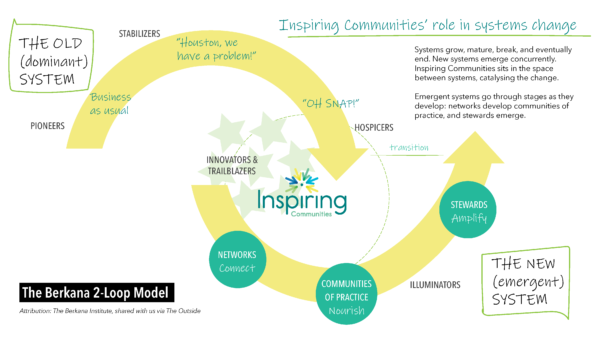
Impact: Integrating Learning
The impact we ultimately aspire to is to make unjust systems equitable. A key part of how we will get there is through learning, and then sharing and integrating that learning. Inspiring Communities is committed to ongoing learning. We learn in many ways, from different sources: formal courses, reflection and evaluation of the innovations we try, from sharing with each other, and from reading and discussing what other organizations are doing.
What we are learning about…
Systems Change Practice
In 2022, our organization took part in a customized joint learning program led by Amanda Rae Storteboom, based on an adaptation of Acumen Academy’s excellent Systems Practice course. This helped us develop common language and a shared understanding of the complexity of systems.
We have also been learning about and applying the Berkana 2-Loop Model, developed by the Berkana Institute.

Governance
Arantzazulab, an organization based in the Basque region, is running an insightful blog series on convening organizations (aka “intermediaries”) like ours, called What Would It Take to Reimagine the Future of Collaborative Governance? It is impactful to read how many of the challenges and experiences we’ve had are common to many other organizations doing this work. We reached out to Arantzazulab to see how we could support their research.
_______________________________
 Executive Director Louise Adongo found this research and upon reading it, said, “This resonates so much that I feel like they have peered into our underwear drawer.”
Executive Director Louise Adongo found this research and upon reading it, said, “This resonates so much that I feel like they have peered into our underwear drawer.”
_______________________________
Here are links to the blogs posted to date:
Part 1: Understanding the actors, roles and conditions required for transformation.
excerpt describing “Beneficial Intermediary”
They are an entity (usually formal) who comes into the ecosystem with the specific purpose of working on behalf of the ecosystem and connecting efforts to amplify the impact that each organisation will have in isolation. They are often considered by other participants of the system as ‘neutral’ or ‘independent’.
How we conceptualise these entities and the language we use to describe them is as complex as the roles they play. Some literature calls them systems convenors, others ecosystem builders, space builders, weavers, connectors or network leaders.
excerpt:
It is not the intention to critique the merits of either form of systems convenor. In practice, it is entirely plausible that both types of systems convenors could operate in the same ecosystem. What is important when considering the creation of future-fit intuitions and governance is that where the impetus for transformation originates, and how the vision, and approach are connected to the broader ecosystem, is likely to have an impact on the transformation outcome and how it occurs.
Part 3: Deep dives into examples of transformation.
Examples of these kinds of initiatives including Participatory Canada and some you are guaranteed not to have heard of.
Part 4: To Come.
_____